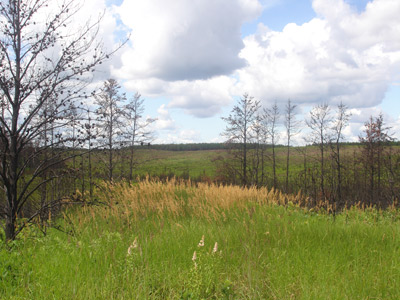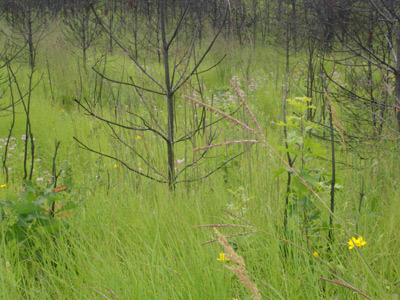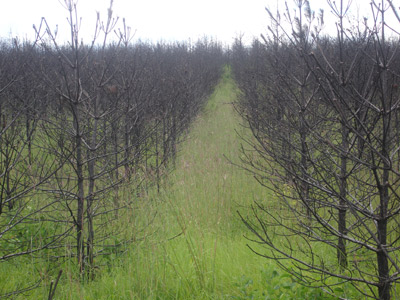FENCEROWS...Burn Country
By John Luthens
The pine barren rows went on in endless succession. Charred landscape rolled out above; ridge after ridge, looking like giant Christmas trees that had been dipped in a burn pile and pulled back out with needles torched to the wind.

Pine barren view in Douglas County.
Summer clouds billowed in the sky, hiding the sun for an instant before quickly passing over the horizon of rolling sand hills. The wind felt fresh when the sun was hidden, and the sedge grass and sweet fern beneath the burned trees rippled in waves.

Grasses and wildflowers flourish beneath the scorched trees.
When the clouds passed and the sun beat back down, there was no shade to be had. Every breath felt hot and the pines didn’t whisper. They crackled together like graveyard skeletons in the breeze.
Scrub oaks spaced themselves unevenly through the furrows and down the sloping valleys. The bigger oaks were blackened like the pines, but many of them still held their brown leaves. The leaves withered beneath the barren sun, but the oaks themselves gave off the impression of survival.
Grasshoppers flew through the air. I have read that they become black after a fire, but they looked like ordinary hoppers to me. Butterflies spread bright wings on wild rose. A robin perched in a burnt jack pine. There was color beneath the darkness of the burned trees and it looked like life was coming back with renewed vengeance.
The northwest Wisconsin Pine Barrens stretch from the Bayfield peninsula southwest through Douglas and Burnett counties to the St. Croix River. They are a savannah of sorts, a highly unique ecosystem with grasses, mixed hardwood and pine clearings, all rolling through the sand in a gentle glacial outwash border land between the prairies of the west and the tall timber of the east.
A crown fire burned through the pine tops in the central section of the barrens in mid-May, set accidentally by a logging crew. The humidity was low and the sand barrens were dry. Only two weeks earlier there was a foot of snow on the ground. Thirty miles away as the crow flies, on Lake Namekagon, the Governor’s Fishing Opener was conducted on ice.
It was still plenty dry. The sand country sucks up moisture like a sponge and the fire could have just as easily been started by a lightning strike from a spring storm. It spread for some 9000 acres through Douglas and Bayfield Counties, taking 47 structures including 17 homes with it before it was contained.

Aftermath of a pine tree crown fire.
The barrens thrive after a burn. Jack pines drop seed cones which are designed to open under intense heat. The jack pines regenerate quickly. Higher canopy oaks and aspen are taken down, providing deadfall shelter for birds and mammals. The grasses and sweet fern rebound, stretching green for acre after acre. Berry bushes, especially blueberry, grow up quickly after a fire. The berry crop increases, providing food for birds and bears alike.
Man-made structures don’t thrive after a burn. The rebuilding process of houses and recreational resorts which have become an integral part of the northwest landscape, a landscape which can boast of having a Governor’s Fishing Opener in any type of weather, is slow and expensive. The barrens are a buffer ecosystem between hardwoods and prairie, but they are also a microcosm of a changing environment, a balancing act where the worlds of civilization and progress collide with the past.
Expert ecologists theorize that at the time of the first European settlement there were 2.3 million acres of pine barrens in Wisconsin. Today only 1 percent of that total remains.
The past glories of Wisconsin logging operations changed the look of the Northwest Pine Barrens. The white and red pines were removed in numbers high enough to boost Wisconsin to the top of the world’s lumber production. Jack pines were clear cut for their pulp and the slash was burned away.
Fire suppression became an integral part of the landscape as farmers moved into the open land, giving hardwood species a competitive advantage and further changing the look of the pine landscape. Fallen leaves from the hardwoods increased the quality of the soil, and in turn more hardwood forest sprang up. The face of the barren’s landscape slowly changed over the course of two centuries.
The fire that burned through the barrens, despite the loss of property (thankfully no lives were lost), has created what is perhaps a one-time chance to glimpse back at what was once a normal part of this dynamic ecosystem.
The horizon stretches, black on the tree line but green and growing beneath. Pine islands still spring to life in the distance. It is a lonely place of wide spaces, wild enough to hold a day’s travel on foot without seeing another living soul.
Piles of logs have been stacked to the side of fire lane roads. The best of the burnt timber has been salvaged before the high winds of autumn and the heavy snows of winter come and push the dead trees into a tangled maze.
I walked sand-shifted fire trails under the summer sky, watching the burnt country and the new life springing from beneath the ground. I rested in the shade of a pine island that had been spared from the fire, by shifting winds or plain luck-it was impossible to know for sure.
It would make a fine deer stand come November, with a rifle and scope, hidden from the open horizon under the pine shelter; more than enough area to roam without bumping into other hunters. I bet I could see every deer in Douglas County. With my shooting, hitting one would be another story.
There were sparse bushes of blueberries. Not enough to fill a bucket, but enough for a lunchtime handful. I expect the berry bushes will produce a bumper crop out here in the coming years.
The logging track I followed out spit me back on the road a mile from my truck. The land looked the same, burnt over but growing back. It is inspiring country, and it’s a miracle that it can grow back up so fast; acre after acre spreading open a look at the past.
It’s always a miracle when I find my way back out of the barrens before dark too. But like my shooting, that’s another story for another time.









